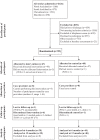Telerehabilitation After Stroke Using Readily Available Technology: A Randomized Controlled Trial
- PMID: 33190615
- PMCID: PMC7739128
- DOI: 10.1177/1545968320971765
Telerehabilitation After Stroke Using Readily Available Technology: A Randomized Controlled Trial
Abstract
Background: The number of people living with stroke has increased demand for rehabilitation. A potential solution is telerehabilitation for health care delivery to promote self-management. One such approach is the Augmented Community Telerehabilitation Intervention (ACTIV). This structured 6-month program uses limited face-to-face sessions, telephone contact, and text messages to augment stroke rehabilitation.
Objective: To investigate whether ACTIV improved physical function compared with usual care.
Methods: This 2-arm, parallel randomized controlled trial was conducted in 4 New Zealand centers. Inclusion criteria were patients with first-ever stroke, age >20 years, and discharged home. A blinded assessor completed outcome measurement in participants' homes at baseline, postintervention, and 6 months postintervention. Stratified block randomization occurred after baseline assessment, with participants allocated to ACTIV or usual care control.
Results: A total of 95 people were recruited (ACTIV: n = 47; control: n = 48). Postintervention intention-to-treat analysis found a nonsignificant difference between the groups in scores (4·51; P = .07) for physical function (measured by the physical subcomponent of the Stroke Impact Scale). The planned per-protocol analysis (ACTIV: n = 43; control: n = 48) found a significant difference in physical function between the groups (5·28; P = .04). Improvements in physical function were not maintained at the 12-month follow-up.
Conclusions: ACTIV was not effective in improving physical function in the ACTIV group compared with the usual care group. The per-protocol analysis raises the possibility that for those who receive more than 50% of the intervention, ACTIV may be effective in preventing deterioration or even improving physical function in people with stroke, in the period immediately following discharge from hospital.
Keywords: randomized controlled trial; stroke; telerehabilitation.
Conflict of interest statement
Figures


References
-
- National Stroke Foundation. Clinical guidelines for stroke management 2010. Accessed October 23, 2020 https://www.pedro.org.au/wp-content/uploads/CPG_stroke.pdf
-
- Hebert D, Lindsay MP, McIntyre A, et al. Canadian stroke best practice recommendations: stroke rehabilitation practice guidelines, update 2015. Int J Stroke. 2016;11:459-484. - PubMed
-
- Gittler M, Davis AM. Guidelines for adult stroke rehabilitation and recovery. JAMA. 2018;319:820-821. - PubMed
-
- Chow CK, Redfern J, Hillis GS, et al. Effect of lifestyle-focused text messaging on risk factor modification in patients with coronary heart disease: a randomized clinical trial. JAMA. 2015;314:1255-1263. - PubMed
-
- Buchholz SW, Wilbur J, Ingram D, Fogg L. Physical activity text messaging interventions in adults: a systematic review. Worldviews Evid Based Nurs. 2013;10:163-173. - PubMed

